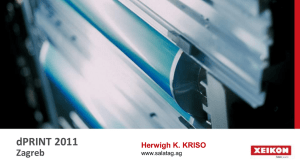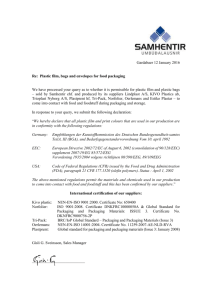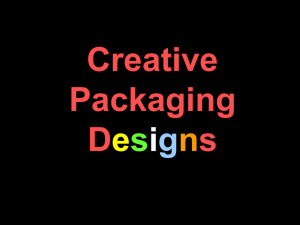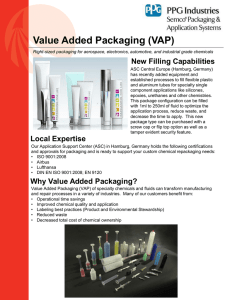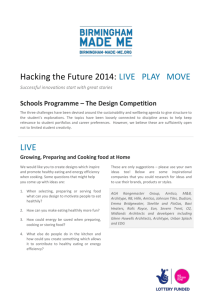B. Tech. (Printing & Packaging Technology) 4th YEAR (7th Semester
advertisement
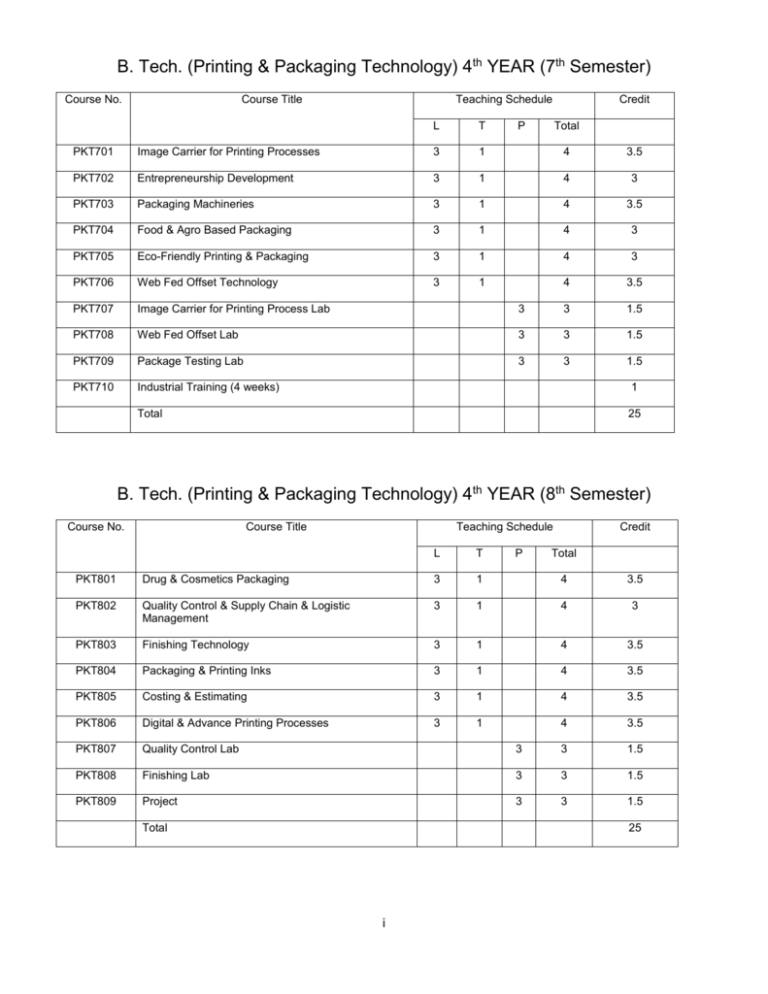
B. Tech. (Printing & Packaging Technology) 4th YEAR (7th Semester) Course No. Course Title Teaching Schedule L T P Credit Total PKT701 Image Carrier for Printing Processes 3 1 4 3.5 PKT702 Entrepreneurship Development 3 1 4 3 PKT703 Packaging Machineries 3 1 4 3.5 PKT704 Food & Agro Based Packaging 3 1 4 3 PKT705 Eco-Friendly Printing & Packaging 3 1 4 3 PKT706 Web Fed Offset Technology 3 1 4 3.5 PKT707 Image Carrier for Printing Process Lab 3 3 1.5 PKT708 Web Fed Offset Lab 3 3 1.5 PKT709 Package Testing Lab 3 3 1.5 PKT710 Industrial Training (4 weeks) 1 Total 25 B. Tech. (Printing & Packaging Technology) 4th YEAR (8th Semester) Course No. Course Title Teaching Schedule L T P Credit Total PKT801 Drug & Cosmetics Packaging 3 1 4 3.5 PKT802 Quality Control & Supply Chain & Logistic Management 3 1 4 3 PKT803 Finishing Technology 3 1 4 3.5 PKT804 Packaging & Printing Inks 3 1 4 3.5 PKT805 Costing & Estimating 3 1 4 3.5 PKT806 Digital & Advance Printing Processes 3 1 4 3.5 PKT807 Quality Control Lab 3 3 1.5 PKT808 Finishing Lab 3 3 1.5 PKT809 Project 3 3 1.5 Total 25 i Image Carrier for Printing Processes (PKT-701) Total Credit: 3.5 Max. Marks: 100 External: 70 Internal: 30 Time Allowed: 3 Hrs. Unit: 1 Introduction to Film Image elements and Assembly of films - Photographic film, camera film, contact film, Room light Handling Films. Proofing Materials – Diazo Papers, Polymer Papers, Brown Print Papers, Diffusion Transfer Materials, Photographic and Stabilization paper. Assembly and masking materials. Basic Steps in Planning a Film Image Assembly. Film assembly for single colour printing and multi colour printing. Planning Consideration for Films and plates – Imposition consideration, Machine Assembly, Book Signature Consideration, and Post Printing Operations. Tools & Equipments & Light Sources for Image Generation – Introduction to tools & equipments used in Preparation of Image carrier for Major printing Processes. Introduction to light source for Plate-making department for various printing processes, Metal Halide Lamps, Laser Source for CTP and CTF. Unit: 2 Image carrier for Offset – Introduction, Types of Plates – Conventional Plates, New Era Plates, Basic steps in preparation of Conventional Plates –Surface Plates and Deep Etch Plates, General processing Sequence for a Positive and Negative Working Plates, General processing Sequence for a New Era Plates – Diazo Plates, PS, Photo polymer, Photo Cross Linking Plates, CTP Plates . Working with CTP Plates, Introduction of Multi-metal plates, Paper/ Film Based Plates. CTP Technology. Image generation for Offset DI Presses. Image Carrier for Gravure – Types of Gravure Cylinder – Mandrel, Integrated shaft, Gravure Image Cylinder Manufacturing – Thin layer Method, Ballard Skin Method, Thick layer Method. Consideration for Image Cylinder Preparation. Gravure Cylinder Imaging Diffusion Etch, Direct transfer, Electro-mechanical process, Laser Cutting Process. Introduction to Gravure Wells and their types. Copper Plating & Polishing, Reuse of Cylinder. Unit: 3 Image Carrier for Flexography – Introduction, Types of Flexography Plates – Rubber and Solid Photo Polymer Plates, Liquid Photo Polymer Plates, their Advantage and Limitations, Base materials for Photopolymer Plates. Plate making process for Rubber Plates, Liquid Photo Polymer Plates, Solid Photo Polymer Plates. Computer to Plate Technology: - Introduction to CtP Technology and their working, Types of CTP and their Plates, Direct Imaging Technology for Image generation. Unit: 4 Image Carrier for upcoming printing Processes: - Driography, Dry-offset, Toray Waterless Plates, and Silicon Plates for Dry offset Printing / Water Less Printing, Image carrier for Screen printing. Quality Control in Image Carrier Department: - Introduction to Quality Control Aids, tools and Equipments. Note: - Examiner is required to set eight questions in all, selecting two questions from each unit. Students will have to answer 05 questions in all, selecting at least one question from each unit. 1 Entrepreneurship Development (PKT-702) Total Credit: 3 Max. Marks: 100 External: 70 Internal: 30 Time Allowed: 3 Hrs. Unit: 1 Entrepreneurship – A Perspective: Recognition of the need for entrepreneurship and selfemployment development, Entrepreneurship spirits. Significance of entrepreneur in Economic Development, Scope and trends of small entrepreneurship, Small business/ enterprise-the driving force for national growth. Unit: 2 Types of small enterprises, Economic, social and psychological need for entrepreneurship, characterization, qualities and pre-requisites of entrepreneur. Quick Start Method: life cycle of new business, selection of a potential entrepreneur, identifying & Evaluating Business opportunities. Unit: 3 Business Planning Process: Why is a good business plan required? Business Plan-the major benefits, sub plan. Forms of Ownership: Different forms of ownership-sole proprietorship, partnership, joint stock company, Selling, Selling your venture, planning for succession. Unit: 4 Instructional Models: Govt. support to new enterprise, incentives, sources of finance. Entrepreneurship Development Centre, Role of Govt. and promotional agencies in Entrepreneurship Development. Entrepreneurship development programmes, Role of various institutions in developing entrepreneurship in India. Ways to be successful entrepreneur in field of printing and packaging. New entrepreneurship aspects. Note: - Examiner is required to set eight questions in all, selecting two questions from each unit. Students will have to answer 05 questions in all, selecting at least one question from each unit. 2 Packaging Machineries (PKT-703) Total Credit: 3.5 Max. Marks: 100 External: 70 Internal: 30 Time Allowed: 3 Hrs. Unit: 1 Packaging of Accessories and Spares - Skin, Blister and Shrink, Packaging: Skin Packaging: Introduction and advantages, Blister Packaging: Introduction, advantages and equipment attached, Shrink packaging: Introduction and Advantages. Stretch Wrapping and Systems: Introduction, Pilferproof packs, pallet stretch wrapping, Material used and advantages. Unit: 2 Strip Packaging: Introduction, Machinery, operating skills, selection of material, machine speed. Blister Packaging: Introduction, Materials, Forming a blister, blister design, continuous blister packing. Unit: 3 Form - Fill - Seal Machine (systems): Vertical and horizontal FFS Machines, Pouch types, Filling operation, Pouch material and its selection. Developments in Packaging of Stand-Up Pouches: Developments in materials, properties and functions. Unit: 4 Blow Moulding Machines: Introduction, concept, Extrusion blow moulding machine, Coextrusion blow moulding. High Flow PEs - a New Trend in Injection Moulded Containers; Plastic Packaging applications, advantages, forms, advantages of injection moulded thin all containers over thermoformed containers, Properties and benefits of PE’s Note: -Examiner is required to set eight questions in all, selecting two questions from each unit. Students will have to answer 05 questions in all, selecting at least one question from each unit. 3 Food and Agro Based Packaging (PKT-704) Total Credit: 3 Max. Marks: 100 External: 70 Internal: 30 Time Allowed: 3 Hrs. Unit: 1 Introduction: Packaging of Processed Foods: Properties, Glass and tin containers, Caps and closures, Other packaging materials, Packaging Machines, Food Processing Techniques: Objectives, Methods, Effects of processing. Packaging of Meat, Fish & Poultry: Introduction, Properties of such food products, Package selection according to spoilage rate criteria and transport conditions. Unit: 2 Packaging of Flesh foods & Fruit Juices: Flesh foods: Characteristics, Processing Methods, Packaging, and Fruit Juices: Introduction, suitability of containers, packaging in flexible materials. Packaging of Dairy Products: Requirements, Package characteristics, Materials and their properties, Packaging of Biscuits, Bread & Confectionery: Introduction, Packaging Materials Used. Unit: 3 Aseptic Packaging - Sterilization of Packaging Materials, Using Aspetic System, Aseptic Packaging, Sterilization by Irradiation, Radiation Sterilization - Process Norms, Guidelines & Applications. Packaging of Ready to Use Foods: Classification, objectives, choice of material, factors affecting rte products, Materials used in Ready to use foods, advantages of RTE. Unit: 4 Packaging of Horticultural crops: Introduction, reasons for spoilage, role of ethylene and its effects on quality, removal of ethylene. Packaging of Fertilizers and Pesticides: Material, Developments, Printing, and optimization of materials. Note: - Examiner is required to set eight questions in all, selecting two questions from each unit. Students will have to answer 05 questions in all, selecting at least one question from each unit. 4 Eco-Friendly Printing & Packaging (PKT-705) Total Credit: 3 Max. Marks: 100 External: 70 Internal: 30 Time Allowed: 3 Hrs. Unit: 1 Introduction: Environment, ecology and sustainable development concept. Printing and Packaging environmental aspects; environmental impacts of printing and packaging operations. Unit: 2 Packaging wastes, effluent treatment and waste minimization. To study reuse, reduce, recycle concept related with printing and packaging. Unit: 3 To study degradable and non degradable printing and packaging materials. Environmental impact including risk assessment, environmental legislation, Packaging effluent and its treatment. Unit: 4 Deming Cycle, Problem Solving, Auditing i.e. Quality safety, environmental integration quality assurance practices into a production stream or packaging line. Supply/ storage/ vaporization, Awareness on-site generation, pressure swing/ membrane/ cryogenic methods, Health and Safety. Energy conservation mechanisms with printing and packaging, Note: - Examiner is required to set eight questions in all, selecting two questions from each unit. Students will have to answer 05 questions in all, selecting at least one question from each unit. 5 Web Offset Technology (PKT-706) Total Credit: 3.5 Max. Marks: 100 External: 70 Internal: 30 Time Allowed: 3 Hrs. Unit: 1 Development and growth of web offset presses : Full size and mini web presses ; four basic types of web offset presses specially used for newspaper and magazine production in single and multi colour Factors to be considered for selecting the press. Components of web offset press ; Infeed, tension control Pre-conditioners, drier and chill rolls, folders, sheeters and winders, Adjustment, operation and maintenance of the major components. Inking systems and dampening systems for web offset: Conventional and non-conventional dampening systems, UV inks and setting systems Causes and correction of ink-related problems Properties and requirements of heat set inks. Web Control: Roll stands and automatic pasters, Detection of web breaks and control of tension, Web Flutter, causes and correction of mis-register Control of fan out, Side lay, cut-off, web-to-web and ribbon control. Unit: 2 Auxiliary equipment: Various types of in-built and optional equipment availability for web-offset and their uses; equipment essentially needed for newspaper & magazine production. Plate and blankets: Various types used for web-offset their characteristics, merits and demerits for specific work, Cylinder pressures and Printing Make-ready. Web-paper: Properties and requirements of paper used for web offset Printability, Care and handling of rolls. Unit: 3 Dry Offset: Why dry-offset; advantages and disadvantages Comparative study of dry offset, letterset and lithographic offset processes, difference between dry offset and letterset machines and inks job suitability. Driography or Waterless lithography: Description of the process, Method of producing image and non-image areas Importance of the correct formulation of waterless lithographic inks. Unit: 4 Introduction to types of drives used in web offset machines. Brief introduction to control pannels of the web offset machines. Folders : Introduction, folding principles, parts of folder, combination folder, ribbon folder, double-former folder, the me-chains of folding process of jaw fold, chopper fold mechanism. Operation of collect cylinder, press folders, double former prefolder, flow folders, insert folders. 8 Inline Finishing: Introduction, gluers, paster wheels, remoisterable pattern gluers, segmented gluers. Note: - Examiner is required to set eight questions in all, selecting two questions from each unit. Students will have to answer 05 questions in all, selecting at least one question from each unit. 6 Image Carrier for Printing Processes Lab (PKT-707) Total Credit: 1.5 Max. Marks: 100 External: 70 Internal: 30 Time Allowed: 3 Hrs. 1. Introduction and Practice of Drawing of layout and preparation of pasting for exposing. 2. Study of Tools, materials and equipments used in Offset Image generation Lab. 3. Study of Tools, materials and equipments used in Flexographic Image Generation Lab. 4. Study of tools, materials and equipments used in Gravure Image Generation Lab. 5. Preparation of various Types of Offset Plates. 6. Preparation of various Types of Flexo-graphic Plates. 7. Preparation of various Types of Gravure Image Cylinder 8. Quality Control equipments and their use in Image carrier department for various processes. 7 Web Offset Technology Lab (PKT-708) Total Credit: 1.5 Max. Marks: 100 External: 70 Internal: 30 Time Allowed: 3 Hrs. 1. Pre-make ready operations. 2. Make ready operations. 3. Multi-color job printing. 4. Study of electronic panel. 5. Blanket and plate cylinder setting. 6. Damping roller setting & Inking roller setting. 7. Study of Web-breaks. 8. Operations of Folding machine &Trouble shooting during printing. 8 Package Testing Lab. (PKT-709) Total Credit: 1.5 Max. Marks: 100 External: 70 Internal: 30 Time Allowed: 3 Hrs. 1. Determination of Burst strength of various packaging materials 2. Determination of Crush strength of various packaging materials 3. Determination of Ply bond strength of various packaging materials 4. Determination of Stiffness of various packaging materials 5. Determination of Scuff resistance of various packaging materials 6. Determination of Heat saleability of various packaging materials 7. Determination of gloss & haze of various packaging materials 8. Measure the color of a packaging material and compute colour differences between different batches 9 Industrial Training (PKT-710) Total Credit: 1 Max. Marks: 100 External: 70 Internal: 30 REPORT OF INDUSTRIAL TRAINING WILL BE EVALUATED BY A COMMITTEE DULY CONSTITUTED BY THE CHAIRMAN 10 Drugs and Cosmetic Packaging (PKT-801) Total Credit: 3.5 Max. Marks: 100 External: 70 Internal: 30 Time Allowed: 3 Hrs. Unit: 1 Packaging of Drugs – Introduction, Classification, design guidelines. Packaging of Drugs -Injectables– Material used for drug packaging: Glass, Rubber, Plastic, Aluminium, paper and board. Unit: 2 Packaging of Drugs-Orals – Package requirements, Forms of ‘Orals’, Materials for oral products packaging, Auxiliary Packaging Materials and Closures. Growth and development of drug packaging industry in India. Unit: 3 Cosmetic Packaging: Introduction, Classification, Factors affecting Cosmetics. Cosmetic Packaging: Cosmetic packaging materials and Techniques. Unit: 4 Growth and development of cosmetic packaging industry in India. Modern trends in drugs & cosmetic packaging. Note: - Examiner is required to set eight questions in all, selecting two questions from each unit. Students will have to answer 05 questions in all, selecting at least one question from each unit. 11 Quality Control & Supply Chain & Logistic Management (PKT-802) Total Credit: 3 Max. Marks: 100 External: 70 Internal: 30 Time Allowed: 3 Hrs. Unit: 1 Introduction : Definition of Quality, Quality control, its meaning and purpose setting up a Quality Control Programme, and establishing necessary System and procedures, economic consideration. Management Consideration: Quality Control as an attitude and management tool, management’s responsibility, organization and personnel functions, getting everybody involved. Total Quality Control. Quality Control procedures and methods. Different shapes of quality control. Unit: 2 Materials Control: Establishing clear specifications and standardization of materials to be purchased particularly Packaging substrates, Inspection and testing of incoming materials as part of quality control; importance of proper handling and maintaining records of performance of materials Sampling and sampling plans. Establishing Quality control programme in different departments of Packaging Plant. Unit: 3 Quality Control Instrumentation : Paper and paper board testing instruments for testing printability, print quality and end-use requirements, Ink testing instruments for testing optical and working properties and end-use requirements Process control instruments, devices and aids used in the galley and dark-room, striping department, plate room and press room for specific processes and for general purposes Press sheet control devices used for production of multi-colour printing jobs Basic principles of these instruments and devices how they function and what they measure, minimum instrumentation necessary to produce a product consistent with the appropriate quality level. Introduction to ISO:9000 and ISO:14000 series. Supply chain management (SCM) – concept of logistics and SCM – decision phases – design, planning and operation – decision areas – type of supply chain views - flows in supply chain – supply chain and competitive performance – performance measures for SCM – strategic fit – drivers of supply chain. Unit: 4 Sourcing and Procurement : sourcing – factors in source selection – vendor rating – qualitative and quantitative methods – purchasing – objectives and procedure – purchasing systems – tender method – computer based systems/EDI – inventory concept – functions of inventory – selective inventory control techniques – structure of inventory problem – costs associated with materials management – relevant costs. Independent demand items – probabilistic – single order quantities – payoff matrix – incremental analysis – mathematical formulation of discrete and continuous cases – independent demand items – deterministic and dynamic – deterministic inventory models without and with backordering – sensitivity analysis – quantity discount – all units and incremental discounts. Independent demand items – probabilistic and dynamic inventory models – Q and P system models – dependent demand items – deterministic models – lot sizing models –lot by lot – EOQ – part period balancing – wagner-within method – concept of just-in-time – kanban – introduction to distribution requirement planning. Note: -Examiner is required to set eight questions in all, selecting two questions from each unit. Students will have to answer 05 questions in all, selecting at least one question from each unit. 12 Finishing Technology (PKT-803) Total Credit: 3.5 Max. Marks: 100 External: 70 Internal: 30 Time Allowed: 3 Hrs. Unit: 1 Introduction : Bindery In The New Millennium, Latest Developments in Print Finishing. Organization and Workshop Layout. Importance of Book Binding. Growths Factors In Print Finishing. Book Binding Tools- Forwarding Tools, Finishing Tools. Binding Room Equipments- Laying Press, Standing Press, Sewing Frame, Glue Pot, Board Cutting. Book Binders Materials & Quality Control. British Standard Paper Sizes. International Paper Sizes. Ra & Sra Sizes. Advantages of Iso Paper Sizes. Board - Kinds of Boards. Reinforcing Materials. Securing Materials, Covering Materials, AdhesivesFactors Governing The Choice Of Adhesives, Use of Adhesives In Print Finishing, Effect of Wet Adhesives. Theories of Adhesives. Principles of Adhesives. Solvent Based Adhesives, Water Based Adhesives, Pressure Sensitive Adhesives. Types of Adhesives. Adhesion- Physical, Specific. Miscellaneous Material. Unit: 2 Hand Folding- Folding To Paper, Folding To Print, Lump Folding, Puckering, Advantages & Limitations of Hand Folding. Machine Folding - Knife Principles, Buckle Principle, Combination of Knife & Buckle. Folding & Machine Direction. Advancements & Developments on Folding Machine, Folding Machine Paper Feeders. Securing Methods: Wire Stitching - Saddle Stiching, Side Stiching, Stabbing. Thread Sewing Adhesive Binding/Perfect Binding - Advantages. Unit: 3 Finishing Processes: Cover Decoration & Other Processes. Print Finishing Operations - Embossing & Debossing, Blind Embossing, Gold Blocking /Foil Stamping. Die Printing. Thermography, Velvet Printing, Marbling, Varnishing, Graining, Laminating, Gumming, Gluing, Punching, Perforating, Drilling. Label Puching, Appliqué. Edge Decoration - Requirement, Colouring The Edges, Marbling Edges, Edge Guilding. Round Corner Cutting. Numbering - Folio Numbering, Double Numbering, Duplicate Numbering. Principle of Rotary Numbering. Skip Numbering, Automatic Numbering. Kindes of Indexes. Banding & Lacing, Poly Bagging, Mailing, Creasing, Bundling, Tacketing. Ultra Violet Curing & Infra Red Curing. Unit: 4 Binding & Finishing Machines : Study of Various Modern Machines. Modern Guillotines - Single Knife Guillotines. Three Knife Trimmers. Knife Grinding M/c. Gold Blocking/Foil Stamping M/c. Wire Stitching M/c. Straw Board Cutter. Laminating M/c - Small Laminating M/c. Pouch Laminating M/c. Tunnel Laminating M/c. Tipping M/c. Smashing M/c. Back Gluing M/c. Roller Gliding M/c. Inline Rounding M/c. Lining M/c. Modern Lining M/c. Cloth Cutting M/c. Foil Blocking M/c. Rotary Blocking M/c. Casing In M/c. Case Making M/c. Box Waste Disposal Process. Box & Carton Manufacturing Process. Adhesive binding machine. Note: - Examiner is required to set eight questions in all, selecting two questions from each unit. Students will have to answer 05 questions in all, selecting at least one question from each unit. 13 Packaging & Printing Inks (PKT-804) Total Credit: 3.5 Max. Marks: 100 External: 70 Internal: 30 Time Allowed: 3 Hrs. Unit: 1 Introduction, solvent based inks, water based ink, ingredients in ink-pigments properties, types, carbon black, inorganic pigments, organic pigments, physical characteristics of organic pigments. Vehicles- vehicles for liquid inks, vehicles for paste inks, UV curing vehicles. Additives – driers, extenders, anti oxidants, waxes. Oils-vegetable drying oils, semi drying oils, non drying oils. Drying mechanisms – physical drying mechanisms, absorption drying, evaporation drying, chemical drying systems, oxidation polymerization drying, radiation drying and curing, microwave drying, infrared drying. Viscosity – Newtonian flow, units of viscosity, viscosity & temperature, factors influencing viscosity, simple low viscosity inks, complex high viscosity inks. Unit: 2 Ink requirements for printing processes – offset, letterpress, flexography, gravure, screen printing. Optical properties of ink films, rheology and ink transfer requirements, ink distribution and transfer on the press, method for the direct measurement of ink setting on coated paper. Printing Ink manufacturing machines & equipments. Paste inks – single roll mill, twin roll mill, triple roll mill, ball mill, twin horizontal mixer, uni-roll mill, high speed stirrer milling. Liquid inks – ball mill, pearl mill, sand mill, bead mill, shot mill. Trends and developments in ink manufacturing process. Unit: 3 Radiation curing: Introduction, radiation curring inks, ink cure considerations, chemistry of uv curring-photo initiation, propagation, termination. Cationic curing, electron beam curing. Security Inks: Range of security inks special security features- fluorescence, phosphorescence, reflected by improved filters, magnetism, security printing inks for cheques-penetrating L/p inks, water fugitive, inks, inks reacting with pen evadicators, red-ox reagents, inks reacting with solvent, invisible reactive inks, carbonizing inks. Unit: 4 Security ink conformity tests and Q.C. teste-tests for chemical resistance, light fastnee, rub resistance test, crumpling resistance test, griding control, colour control, control of the rheological properties, control of drying time, control of various specific properties. Environmental consideration in security printing. Study light fastness of inks, factors affecting light fastness of ink, new improvements in light fastness properties of inks. Note: -Examiner is required to set eight questions in all, selecting two questions from each unit. Students will have to answer 05 questions in all, selecting at least one question from each unit. 14 Costing & Estimating (PKT-805) Total Credit: 3.5 Max. Marks: 100 External: 70 Internal: 30 Time Allowed: 3 Hrs. Unit: 1 Concept of cost, Analysis of cost, fixed cost, variable cost, Elements of cost and its method of recovery. Function and Purpose of costing and estimating from printer’s point of view & customer’s point of view, Difference between costing and estimating, Qualification of an estimator, estimators tools. Introduction to finance & DBMS. Unit: 2 Job costing, its need and procedures, Cost sheet, Daily Docket, WIT and its importance in costing. Type of costing system for printing industry & related problem. Unit: 3 Estimating paper- selection of papers, allowance for wastage, allowance for trimming, weight of loose sheets, and weight of reel of papers. Estimating inks – Inks consumption formula, Ink allowance for spoilage. Unit: 4 Estimating binding materials – board requirement, covering materials. Estimating sewing thread, estimating wire, estimating adhesives. Note: -Examiner is required to set eight questions in all, selecting two questions from each unit. Students will have to answer 05 questions in all, selecting at least one question from each unit. 15 Digital & Advance Printing Processes (PKT-806) Total Credit: 3.5 Max. Marks: 100 External: 70 Internal: 30 Time Allowed: 3 Hrs. Unit: 1 Digital Documents: Introduction to Digital Printing fundamentals Pixel image, Digital image, Digitization, Half toning colour reproduction, colour jumbs, resolution and its qualities. Acquiring: Scanning of different original, Selection of technology of Programme. Transfer of Digital Photographs. Unit: 2 Documentation: Image file formats, TIFF, EPS JPEG files text files and past discription languags. Digital Printing Processes, Silver faldire, Phernal, Inkjet, electrostatic processes. Unit: 3 Rendering Type line Art and images. Colour management, Introduction and future, Characterizing input and output device use of CIELAB, CMS. Market & Applications: Introduction. Defining on demand. Defining Digital Printing. Defining variable printing. Typical lengths. Short- run process colour printing. On demand printing & Publishing concepts. Future on-demand. Market research Where are pages created. Number of originals and run length. New technologies shift existing methods. Economics of on demand printing - Economics of long run. Advantage for the buyer. Efficiencies of Digital on demand work flow. Shortrun pricing paradox. Unit: 4 Advance printing processes and techniques and Hybrid systems for printing on pre formed objects. Various methods to take care of counterfeiting in printing & packaging. Networking:Networks for printing. Networks for publishing. Networks for Inhouse. Ideal Network. WAN (Wide Area Networks). Flexibility. Changing Markets for Print. Market projections, Projection of changes in the no.of colors. Moving towards shorter runs. Note: - Examiner is required to set eight questions in all, selecting two questions from each unit. Students will have to answer 05 questions in all, selecting at least one question from each unit. 16 Quality Control Lab (PKT-807) 1. Total Credit: 1.5 Max. Marks: 100 External: 70 Internal: 30 Time Allowed: 3 Hrs. Tensile strength, burst strength, Substance, caliper, porosity test, cobb sizing value test. 2. Tearing , brightness, gloss test, G.S.M. testing, Weight, folding endurance and other related tests. 3. Moisture contents test, ash contents test. 4. Hot air oven tester, absorbing test. 5. Pick strength, humidity control test, room temp testing. 6. Ink film thickness test. 7. Investigation of pigment properties. 8. Investigation of solvent properties. 17 Print Finishing Lab (PKT-808) Total Credit: 1.5 Max. Marks: 100 External: 70 Internal: 30 Time Allowed: 3 Hrs. 1. Preparation of writing board. 2. Preparation of Photo Album. 3. Preparation of following type of Mechanical binding - Spiral wire binding, Wire ‘O’ binding, Ring binding. 4. Preparation of files of following designs - Loose leaf file - single piece, loose leaf file - Two piece tab binder, loose leaf guard file - Boards joined with spine strip, Court case file, Portfolio - Closed file to keep confidential loose sheets. 5. Preparation of telephone directory with Indexes and Tabs. 6. Study of various controls, operations and mechanisms of the following machines: Folding machine, Guillotine machine, Cutter and Creaser, Varnishing machine, Laminating machine, Miscellaneous machines. 7. Print finishing operation to be conducted, Gold blocking, Embossing, Edge decoration, 8. Thermography, Marbling, Velvet printing, Rubber printing, Die printing, Pouch lamination. 18 Project (PKT-809) Total Credit: 1.5 Max. Marks: 100 External: 70 Internal: 30 Project will be an innovative working model of machine/ equipments used in Printing & Packaging Industry with required modifications and will be demonstrated during examination with the help of project report by a group of maximum ten students under the guidance of project guide (Regular faculty member of the department). 19

